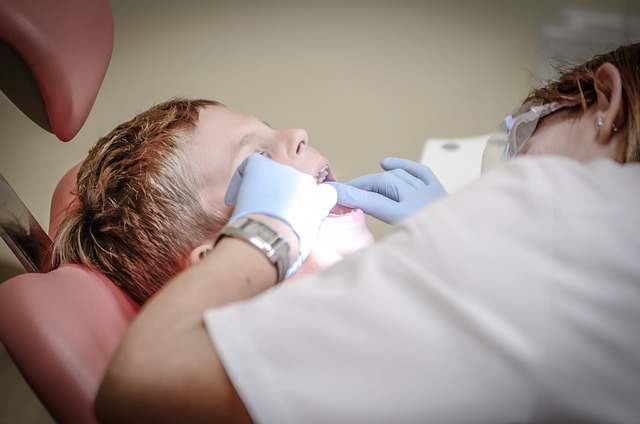The Gauze Aftermath: A Helpful Guide for Tooth Extraction Recovery
Welcome to “The Gauze Aftermath: A Helpful Guide for Tooth Extraction Recovery!” If you’ve recently undergone a tooth extraction, we understand that the recovery process can sometimes feel overwhelming or uncertain. But fear not, because we’re here to provide you with all the information you need to???? make your recovery journey as smooth as possible. In this article, we will walk you through the steps of post-extraction care, share tips on managing discomfort, and provide invaluable advice for a speedy and successful ????healing process. So sit back, ????relax, and let us guide you towards a comfortable and healthy recovery after your tooth extraction.
If you’re scheduled to have a tooth extraction, it’s natural to have some questions and concerns about what to expect. Understanding the process can help alleviate any anxieties you may have. Here are some key points to keep in mind:
-
????
- Preparation: Prior to the extraction, your dentist will thoroughly examine your tooth and ????take X-rays ????to assess the situation. They will discuss any necessary preparations or precautions with you.
- Anesthesia: Generally, a local anesthesia will be used to numb the area around the tooth, ensuring you don’t feel any pain during the extraction. In some cases, your dentist may recommend additional sedation ????to help you relax.
- The Procedure: During the extraction, ????your dentist will carefully loosen the tooth using specialized tools. Once???? loose, they will gently remove it, ensuring minimal???? discomfort or bleeding. If needed, sutures may be placed to aid in healing.
- Recovery and Aftercare: Following the procedure, your dentist will provide you with detailed instructions for proper care and recovery. This will likely include medication, special eating guidelines, and avoiding vigorous activities for a few days. It’s important to follow these instructions to promote optimal healing.
????
????
???? Remember, every tooth extraction is unique, and the specifics of your experience will depend on factors such as???? the tooth’s condition and your overall oral health. By understanding what to expect, you can approach your extraction with confidence, knowing you’re in capable hands.
????

2. Preparing for a Successful Recovery after Tooth Extraction
After a tooth extraction, it’s important to take proper care of your mouth to ensure a smooth and successful recovery. Here are some tips to help you prepare:
-
- Stock up on soft foods: Your mouth will be tender and sensitive after the extraction, so ????it’s best to stick to a diet of soft, easy-to-chew foods. Consider stocking your kitchen with options like yogurt,???? mashed potatoes, soup, and smoothies.
- Keep the extraction site clean: Gentle rinsing with warm saltwater is a great way to keep the area clean and prevent infection. Avoid using a straw or smoking, as these can dislodge the blood clot and delay healing.
- Manage pain and swelling: It’s ????normal to experience some???? discomfort and swelling after the extraction. Over-the-counter pain relievers like ibuprofen can help alleviate the pain. Applying an ice pack to your cheek in 15-minute intervals can also reduce swelling.
Follow these precautions and you’ll be well on your ????way to a successful recovery. Remember, don’t hesitate to reach out to your dentist if you have any concerns or experience ????severe pain or complications.
Gauze is a vital tool in the ????recovery process following a tooth extraction. It plays a???? crucial role in promoting healing and reducing the risk of complications. Here, we’ll explore why???? gauze is important ????and how it can aid in your recovery. Preventing bleeding: The primary function of gauze after ????a tooth extraction is to control bleeding. Placing a clean, folded piece of gauze on the extraction site and applying gentle pressure helps to form a blood clot, which is essential for the healing process. This???? clot acts as a ????protective barrier, preventing excessive bleeding and minimizing the chances of developing a condition called dry socket. Protection and cleanliness: Gauze not only helps in reducing bleeding, but it also provides a protective covering for the???? wound. By keeping the extraction???? site clean and free from external contaminants, gauze assists in preventing infections. Additionally, gauze acts as ????a cushion, guarding the area from accidental biting or trauma, which can delay the healing process. After a tooth extraction, proper gauze placement is???? crucial for promoting healing???? and preventing complications. Follow this step-by-step guide???? to ensure correct gauze placement: 1. Clean and wash your hands: ????Before touching the gauze or the extraction???? site, make sure to wash your hands ????thoroughly with soap and warm water. This will help prevent any bacteria from entering the wound. 2. Fold the gauze: Take a piece of sterile gauze and fold it into a small square. The size of the gauze should be big enough to cover the extraction site completely. 3. Position the gauze: Carefully place the folded gauze directly over ????the extraction site, applying gentle pressure to ????ensure it stays in place. The gauze should cover the socket completely, helping to control bleeding and absorb any excess ????blood. 4. Bite down gently: ????Once the gauze is???? properly positioned, bite down on it gently but firmly. This pressure will promote the formation of a blood clot, which is important for the healing???? process. 5. Replace the gauze: After about 30 minutes, remove the gauze and check for any excessive bleeding. If bleeding persists, replace the???? gauze with a fresh piece and continue biting down for another???? 30 minutes. Remember to follow???? any specific instructions provided by your dentist or oral surgeon. If you experience severe bleeding, intense pain, or any other concerns, don’t hesitate ????to seek professional help. Recovering from a tooth extraction can be an uncomfortable process, but proper management of pain and discomfort can significantly improve your healing journey. One essential tool in this process???? is gauze, which plays a crucial role in aiding your recovery. By understanding how to use gauze effectively, you can minimize pain, reduce bleeding, and support the formation of a blood clot to ensure a smooth and swift recovery. First and foremost, gauze is commonly used to control bleeding after a tooth extraction. By gently biting down on a gauze pad for 30-45 minutes, pressure is applied to the extraction site, promoting the formation of a blood clot. This clot ????is crucial for the initial stages of ????healing, as it helps protect the wound and aids in the formation of new tissue. Remember to bite down firmly but not excessively to avoid dislodging the clot. Gauze can also absorb excess saliva and help keep the extraction site clean, promoting a hygienic environment for healing. Placing a fresh gauze pad over the extraction ????site not only aids in ????the prevention of infection but can also provide???? relief by reducing discomfort and ????numbing the area.???? Always follow your dentist’s instructions on how to use and replace gauze, ensuring proper care and a speedy recovery. After a tooth extraction, proper gauze aftercare is crucial for optimal healing and to minimize any potential complications. Here are some helpful tips to ensure a speedy and comfortable recovery: Furthermore, follow these additional tips???? to ensure???? successful gauze aftercare: ???? By following these gauze aftercare tips, you can???? support optimal healing and ensure a smooth recovery after your tooth extraction. After a tooth extraction, it’s crucial to take the necessary steps???? for a smooth healing process. One???? of these steps includes the proper removal of gauze.???? Gauze plays a vital role in controlling bleeding and promoting blood clot formation, but it should be removed ????carefully to avoid any complications. Here are a few tips to ????help you remove gauze easily and ensure a comfortable recovery: Remember, it’s essential to be cautious while removing the gauze to prevent???? any complications or unnecessary discomfort. If you experience prolonged bleeding, severe pain, or any other concerning symptoms, reach out to your dentist immediately for???? guidance. By following these tips, you’ll ensure a smooth transition after tooth extraction and pave the way for a speedy recovery. During the recovery process after a tooth extraction, it is common to ????experience certain challenges. Fortunately, gauze can be an???? invaluable tool to help alleviate some of these discomforts. Here are???? some of???? the common challenges faced during tooth extraction???? recovery and how ????gauze can provide relief: Bleeding is a normal part of???? the healing process, but if it persists for an extended period, it can be concerning. To control bleeding effectively, fold a piece of sterile gauze into a ????small, firm pad and place???? it over the extraction site. Apply gentle pressure by biting down to promote blood clotting. Remember to replace the???? gauze every 30 to 45 minutes as needed until the bleeding diminishes. ???? Swelling and discomfort around ????the extraction site ????are common post-operative symptoms. Using gauze as a ????cold compress can ????help reduce swelling and???? numb the area, providing much-needed relief. Wrap a few ice cubes in a thin cloth or place a cold gel pack in a plastic bag and cover it with a piece of gauze. Apply the cold compress to the affected area for 15 minutes, allowing the cold temperature to ease both swelling and discomfort. ????Remember to take regular breaks between applications???? to prevent frostbite.
When it comes to tooth ????extraction recovery, gauze is undoubtedly the best option available. While there are alternatives out there, gauze???? provides the ideal combination of absorbency, softness, and flexibility ????that is essential for a successful recovery process. Let’s take a closer look at why gauze reigns supreme in this regard.
1. Superior Absorbency: Gauze is highly absorbent, making it incredibly effective at soaking up blood and other fluids that may be present after a tooth extraction. Its ability to create a clean and dry environment significantly reduces the risk of ????infection and promotes faster healing.
So, you’ve just had a tooth extraction—congratulations on getting through it! As you recover, it’s important to keep an eye out for signs indicating that it’s time to say goodbye to the gauze in your mouth. Here are a few things to watch out for:
Q: What is the purpose???? of this article about tooth extraction recovery using gauze? Q: Why is gauze important after a tooth extraction? Q: How should gauze be used after a tooth extraction? Q: Is it normal to experience bleeding???? after a tooth extraction? Q: How long should gauze be used for after a tooth extraction? Q:???? Can gauze be changed during the recovery period? Q: What should I do if bleeding persists even ????after using gauze? Q: Are ????there any alternative materials that can be ????used instead of gauze? Q: Are there any precautions to take during tooth extraction recovery? Q: Is???? there any way to reduce swelling after a tooth extraction? Q: Are there any ????foods to avoid during tooth extraction recovery? Q: How long does it usually take to fully ????recover from a tooth extraction? Q: Should I follow any specific???? oral hygiene routines after a tooth extraction? Q: What should I do if I have any concerns or experience unusual symptoms during recovery? We hope you found this helpful guide on tooth extraction recovery to be informative and comforting. ????Remember, the aftermath of a tooth extraction can be a daunting experience, but with the right knowledge and proper care, you can make your recovery period???? as comfortable and smooth as possible. As you progress through the various???? stages of healing, remember to follow your???? dentist’s instructions while also listening to your body. Each ????person’s recovery journey may differ slightly, so be patient with yourself and take the time you need to???? heal fully. Remember, slow and steady wins the race! During the gauze aftermath, the key is to maintain good oral???? hygiene and minimize unnecessary discomfort. Whether it’s managing pain, controlling swelling, or dealing with post-operative bleeding, there are numerous practical strategies you can implement to speed up your recovery. Don’t hesitate to reach out to your dentist if you have any concerns or???? questions along the way. While the recovery process may seem never-ending, remember that brighter days are just around the corner. Soon enough, you’ll be back to enjoying all your favorite foods ????and living pain-free with a healthier, happier smile. So take it easy, relax, and let your body ????do what it does best – heal. Lastly, we’d like to thank you for choosing this helpful guide to navigate your tooth extraction recovery. We hope it has provided you with the support and information you were seeking. Here’s to a swift and successful recovery process, and may you soon be back to flashing that beautiful, confident smile! 

5. Managing Pain and Discomfort: Gauze’s Role in Tooth Extraction Recovery
6. Gauze Aftercare: Tips for Optimal Healing after Tooth Extraction
???? ????
7. Gauze Removal Made Easy: Ensuring a Smooth Transition after Tooth Extraction
8. Common???? Challenges during Tooth Extraction Recovery and How Gauze Can Help
Persistent Bleeding
Swelling and Discomfort
9. Gauze versus Alternatives: Why it Remains the Best Option for Tooth Extraction Recovery
2. Soft and Gentle: One of the most crucial factors during tooth extraction recovery is maintaining a comfortable experience. Gauze’s soft and gentle texture helps avoid irritation and discomfort, ????ensuring a pain-free recovery process.
3. Flexibility: Gauze is incredibly versatile, allowing it to conform to the shape of???? the extraction site. This ????flexibility enables it to offer optimal coverage, protection, and support to the healing area, preventing accidental dislodgement???? of the blood clot and promoting proper healing.
Frequently ????Asked Questions
A: The purpose of this article is to provide a helpful guide for tooth extraction recovery, specifically focusing on the use of gauze afterwards.
A: Gauze plays a crucial role in tooth extraction recovery as it helps control bleeding, protects the extraction site, and promotes the formation of a blood clot to aid in healing.
A: After???? extraction, fold a piece of dry gauze into a pad and gently bite down on it, applying firm and continuous pressure ????for about 30 minutes.???? This will help stop the bleeding and facilitate the formation of a blood clot.
A: Yes, some bleeding is normal after a tooth extraction. However, excessive or prolonged bleeding should ????be brought to the attention of your???? dentist immediately.
A: Typically,???? it is recommended to use gauze for about 1 to 1.5 hours after the tooth extraction. However, the duration may vary, so it’s important to follow your dentist’s instructions.
A: Generally, it is not necessary???? to change gauze pads unless they become soaked with blood. However, if your dentist advises changing the gauze, make sure to follow their ????instructions.
A: If bleeding persists beyond the initial recovery period, continue applying fresh gauze pads following the same process. If the bleeding still does not stop, contact your dentist immediately for further ????guidance.
A: While gauze is commonly used, dental professionals may sometimes recommend alternative materials such as teabags or
A: It is important to avoid activities that may dislodge the???? blood clot, such as spitting forcefully, drinking through a straw, or smoking.???? Follow your dentist’s post-extraction instructions to ensure a smooth recovery.
A: To reduce swelling, apply an ice pack or a cold compress ????on the ????affected area in the first 24 hours after the???? extraction. Be sure to wrap the ice pack with a cloth to prevent direct contact with the skin.
A: It is best to avoid consuming hot, spicy, or hard foods that might irritate the ????extraction ????site.???? Opt for soft foods and???? liquids, and???? slowly reintroduce a normal diet as advised by your dentist.
A: The recovery period varies depending on the complexity of the extraction and each individual’s healing process. However, it usually takes about 7 to 10 days to fully recover from a ????routine tooth extraction.
A: Yes, it is important to maintain good oral hygiene even after a tooth extraction. Gently brush your teeth, avoiding the extraction site, for the first 24 hours. After this initial period, ????you can rinse your mouth with warm saltwater.
A: If you have any concerns, experience excessive pain, swelling, prolonged bleeding, or any other unusual symptoms, reach out to your dentist immediately. They will be able to address???? your???? concerns and provide appropriate guidance. Conclusion







